Click on images to enlarge
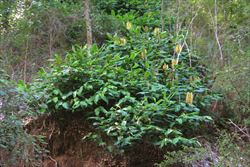
infestation (Photo: Forest and Kim Starr, USGS)
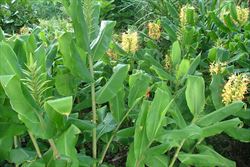
habit in flower (Photo: Sheldon Navie)

habit in fruit (Photo: Forest and Kim Starr, USGS)

rhizomes and bases of upright stems (Photo: Sheldon Navie)
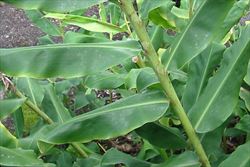
stem and leaves (Photo: Sheldon Navie)
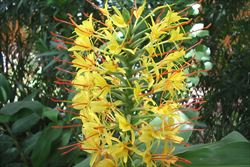
large flower cluster (Photo: Sheldon Navie)
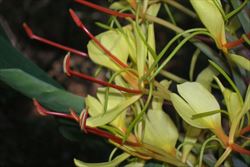
close-up of yellow flowers with red stamens (Photo: Forest and Kim Starr, USGS)
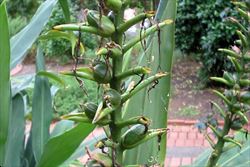
floral bracts and immature fruit (Photo: Sheldon Navie)

mature fruit (Photo: Forest and Kim Starr, USGS)
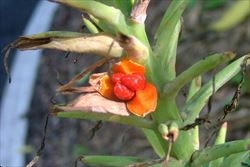
close-up of open fruit with orange insides and bright red seeds (Photo: Sheldon Navie)
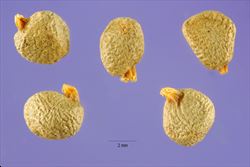
close-up of seeds after fleshy red arils have been removed (Photo: Steve Hurst at USDA PLANTS Database)
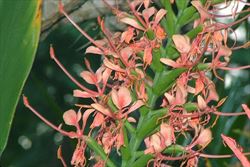
red ginger (Hedychium coccineum) with reddish-pink flowers and stamens (Photo: Sheldon Navie)
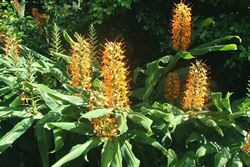
Hedychium gardnerianum 'Tara' with orange flowers (Photo: Sheldon Navie)
Scientific Name
Hedychium gardnerianum Sheppard ex Ker Gawl.
Synonyms
Family
Zingiberaceae
Common Names
ginger lily, yellow ginger lily, kahila garland-lily, kahili garland lily, kahili ginger, kahili ginger lily
Origin
Native to the Indian Sub-continent (i.e. Bhutan, Nepal and northern India).
Cultivation
This species is a very common and widely cultivated garden ornamental in Australia. The cultivar Hedychium gardnerianum 'Tara', which has orange flowers, is also quite common in cultivation. However, there is some evidence that this "cultivar" may actually be a hybrid of Kahili ginger (Hedychium gardnerianum) and red ginger (Hedychium coccineum).
Naturalised Distribution
Naturalised in the coastal districts of eastern Australia (i.e. in central and northern New South Wales and south-eastern Queensland). Also sparingly naturalised near Melbourne in southern Victoria.
Naturalised overseas in southern Africa, La Réunion, New Zealand, the Caribbean and Hawaii.
Habitat
A weed of native bushland, rainforests, closed forests, forest margins, watercourses and riparian habitats in sub-tropical and warmer temperate regions (particularly near urban areas).
Habit
A long-lived (i.e. perennial) herbaceous plant usually growing 1-2 m tall, but occasionally reaching up to 2.5 m in height.
Distinguishing Features
- a large herbaceous plant with short-lived upright flowering stems growing up to 2.5 m tall.
- it re-grows and spreads via long-lived creeping underground stems.
- its large alternately arranged leaves (20-45 cm long and 10-15 cm wide) have a long base that sheaths the stems.
- its showy flowers are borne large clusters (15-45 cm long and 15-20 cm wide) at the tips of the upright stems.
- these flowers are mostly bright yellow with a single large bright red stamen.
- its capsules (about 1.5 cm long) split open when mature to reveal bright orange inner surfaces and bright red seeds.
Stems and Leaves
This species produces long-lived (i.e. perennial) creeping underground stems (i.e. rhizomes) and short-lived (i.e. annual) upright (i.e. erect) flowering stems. It is occasionally also seen growing as an epiphyte on trees.
The large leaves are alternately arranged along the stems with a long base that sheaths the stems. These glossy leaves (20-45 cm long and 10-15 cm wide) are relatively narrow (i.e. lanceolate to narrowly elliptic) with entire margins and pointed tips (i.e. acuminate apices). Where the leaf sheath meets the leaf blade there is a broad membrane (i.e. ligule) up to 2.5 cm long and 2 cm wide. Just above the sheath, the leaf blade is narrowed into a stalk-like base about 1-2 cm long.
Flowers and Fruit
The showy flowers are borne large spike-like clusters (15-45 cm long and 15-20 cm wide) at the tips of the stems. There are narrow green bracts (3-5 cm long) below each group of one or two flowers. The flowers are mostly bright yellow with three large 'petals' (i.e. inner tepals) that are fused together at the base into a narrow tube about 5 cm long. Their lobes are relatively narrow (i.e. linear or lanceolate) and 3.5-5 cm long. There is also a fourth smaller petal-like structure (i.e. a labellum) which is spoon-shaped (i.e. spathulate) and two-lobed (2.5-3 cm long and 8-13 mm wide). The greenish coloured 'sepals' (i.e. outer tepals) are fused into a tube (3-3.5 cm long) and are inconspicuous. There are also two elongated greenish-yellow structures (about 3 cm long) that are modified from stamens (i.e. staminodes), and a single large fully-functional stamen. This stamen is borne on a long bright red filament (5.5-7 cm long). Flowering occurs mostly during summer and autumn.
The fruit is a thin-walled capsule (about 1.5 cm long) with three compartments. It splits open when mature to reveal bright orange inner surfaces. The relatively large brown seeds (5-6 mm long) have a bright red fleshy covering (i.e. aril).
Reproduction and Dispersal
This species reproduces by seed and also vegetatively via its creeping underground stems (i.e. rhizomes).
The seeds are readily dispersed by birds and other animals that are attracted to their bright colours. Seeds and segments of its creeping underground stems (i.e. rhizomes) may also be dispersed by water and in dumped garden waste.
Environmental Impact
Kahili ginger (Hedychium gardnerianum) is regarded as an environmental weed in Queensland and New South Wales. It forms vast, dense, colonies that smother and displace native groundcover vegetation. These dense stands also can prevent the regeneration of trees and shrubs, significantly modify the habitat available to native animals, and eventually threaten the integrity of the forest ecosystems. This species prefers moist habitats, can tolerate shade, and can dominate riparian areas and the understorey of wetter forests in sub-tropical and tropical regions.
Kahili ginger (Hedychium gardnerianum) has escaped cultivation in south-eastern Queensland and is spreading into rainforest at Mt Glorious, Mt Nebo, Springbrook National Park, Lamington National Park, Mt Tamborine and Buderim. It is also reported to be invading rainforest near Mackay in central Queensland. It was recently ranked among the top 200 most invasive species in south-eastern Queensland and is regarded as a serious threat to sub-tropical and tropical rainforests throughout Queensland.
This species is also naturalised in moist habitats north from the Sydney area in New South Wales and invades sub-tropical and warmer temperate rainforests in this state (e.g. Goonengerry National Park on the North Coast and Lane Cove National Park in northern Sydney). It also invades creek banks and watercourses close to urban areas in the Sydney region. Kahili ginger (Hedychium gardnerianum) is regarded as a potentially significant environmental weed throughout the coastal districts of New South Wales and appears on numerous local and regional weed lists in the eastern parts of this state (e.g. in the North Coast region, the Sydney North region, Byron Shire, the wider Sydney and Blue Mountains region, Coffs Harbour, Lismore, Warringah Council, Blue Mountains Shire, Sutherland Shire and the South Coast region).
Overseas, Kahili ginger (Hedychium gardnerianum) has caused even greater environmental impacts. It is a major invader of native forests in New Zealand and Hawaii, and is also a problem species in South Africa and La Réunion. This species is listed in the Global Invasive Species Database, and is considered to be among the top 100 of the world's worst invasive alien species.
Other Impacts
Kahili ginger (Hedychium gardnerianum) is also very poisonous to grazing animals, and can be fatal if enough of the plant is ingested.
Legislation
Not declared or considered noxious by any state government authorities.
Management
For information on the management of this species see the following resources:
- the Sutherland Shire Weed Fact sheet on this species, which is available online at http://www.sutherland.nsw.gov.au.
Similar Species
Kahili ginger (Hedychium gardnerianum) is similar to white ginger (Hedychium coronarium), yellow ginger (Hedychium flavescens) and red ginger (Hedychium coccineum). Only some of these species are currently known to be naturalised, but all are relatively common in cultivation. Hybrids between these species are also produced, and may exhibit intermediate characteristics. However, these species can be distinguished by the following differences:
- Kahili ginger (Hedychium gardnerianum) has yellow flowers with bright red stamens. The flowers are arranged in a large elongated cluster 15-45 cm long.
- white ginger (Hedychium coronarium) has white flowers with white stamens. The flowers are arranged in relatively short cluster 7-20 cm long.
- yellow ginger (Hedychium flavescens) has pale yellow flowers with yellow stamens. The flowers are arranged in relatively short cluster 15-20 cm long.
- red ginger (Hedychium coccineum) has reddish, salmon or pink flowers with stamens that are the same colour as the petals. The flowers are arranged in a large elongated cluster usually more than 25 cm long.
Kahili ginger (Hedychium gardnerianum) is also similar to the cannas (Canna spp.) and native ginger (Alpinia caerulea). The cannas (Canna spp.) can be distinguished by their roughly textured capsules and hard black seeds, while native ginger (Alpinia caerulea) can be distinguished by its much smaller whitish flowers and bright blue rounded fruit.

